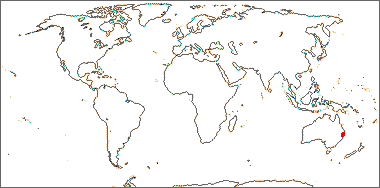Family name: Petermanniaceae Hutch.
Synonym(s): [none]
Common name(s): petermannia family
*Number of genera/species: 1/1
List of genera records in GRIN-Global
fruit
Fruit a berryberry:
an indehiscent, fleshy fruit with one or a few to many seeds. The flesh may be homogenous throughout. Or, if the outer part is hard, firm, or leathery, referred to as an hesperidium. Septa are present in some, and the seeds may be arillate or with a fleshy testa. , 7–18 mm long, globoseglobose:
, 7–18 mm long, globoseglobose:
3D shape—more or less spherical , tereteterete:
, tereteterete:
approximately circular in cross section; width and thickness approximately equal
 in transection, with many-seeds. Pericarppericarp:
in transection, with many-seeds. Pericarppericarp:
fruit wall or fruit coat
red, fleshy, thick.
Seeds globoseglobose:
3D shape—more or less spherical , somewhat angularangular:
, somewhat angularangular:
2D shape—having sides that meet at acute or obtuse angles
. Seed coat brown, thick, hard, wrinkledwrinkled:
surface relief—shallow, irregular folds and furrows covering the surface; appearing overall though crumpled and then spread out .
.
Embryo linearlinear:
(shape) long, narrow, and uniform in width; (of embryo) embryo is straight and much longer than wide , curvedcurved:
, curvedcurved:
(of embryo) linear embryo is curved into an arch or horseshoe with the ends far apart .
.
Endosperm copious.
| Fruit | |
| Type | berryberry: an indehiscent, fleshy fruit with one or a few to many seeds. The flesh may be homogenous throughout. Or, if the outer part is hard, firm, or leathery, referred to as an hesperidium. Septa are present in some, and the seeds may be arillate or with a fleshy testa.  |
| Size range | 7–18 mm long |
| Shape(s) | globoseglobose: 3D shape—more or less spherical  |
| Texture | fleshy |
| Color(s) | red |
| Unique features | Red, fleshy, thick walled, globoseglobose: 3D shape—more or less spherical  berriesberry: berriesberry:an indehiscent, fleshy fruit with one or a few to many seeds. The flesh may be homogenous throughout. Or, if the outer part is hard, firm, or leathery, referred to as an hesperidium. Septa are present in some, and the seeds may be arillate or with a fleshy testa.  . . |
| Seed | |
| Shape(s) | globoseglobose: 3D shape—more or less spherical  , polygonalpolygonal: , polygonalpolygonal:angular |
| Surface relief | wrinkledwrinkled: surface relief—shallow, irregular folds and furrows covering the surface; appearing overall though crumpled and then spread out  |
| Color(s) | brown |
| Unique features | Brown seeds with thick, wrinkledwrinkled: surface relief—shallow, irregular folds and furrows covering the surface; appearing overall though crumpled and then spread out  seed coats. seed coats. |
| Other | |
| Embryo | linearlinear: (shape) long, narrow, and uniform in width; (of embryo) embryo is straight and much longer than wide  , curvedcurved: , curvedcurved:(of embryo) linear embryo is curved into an arch or horseshoe with the ends far apart  |
| Nutritive tissue | endosperm copious |
Eastern Australia.

Distribution map courtesy of Angiosperm Phylogeny Website.
Baskin and Baskin 2021Baskin and Baskin 2021:
Baskin C and Baskin J. 2021. Relationship of the lateral embryo (in grasses) to other monocot embryos: A status up-grade. Seed Science Research 31 (3): 199-210. doi:10.1017/S0960258521000209; Dahlgren et al. 1985Dahlgren et al. 1985:
Dahlgren RMT, Clifford HT, and Yeo PF. 1985. The families of the monocotyledons: structure, evolution, and taxonomy. Springer-Verlag, Berlin. 520 pp.; Flora of Australia 2021+Flora of Australia 2021+:
Flora of Australia. Australian Biological Resources Study, Canberra. Accessed January 2021–March 2024. URL: http://www.ausflora.org.au; Kirkbride et al. 2006Kirkbride et al. 2006:
Kirkbride JH, Jr, Gunn CR, and Dallwitz MJ. 2006. Family guide for fruits and seeds, vers. 1.0. Accessed September 2020-January 2022. URL: https://nt.ars-grin.gov/seedsfruits/keys/frsdfam/index.cfm .; Kubitzki et al. 1990+Kubitzki et al. 1990+:
Kubitzki K et al., eds. 1990+. The families and genera of vascular plants. 7+ vols. Berlin etc.; Stevenson and Loconte 1995Stevenson and Loconte 1995:
Stevenson DW and Loconte H. 1995. A cladistic analysis of monocot families. In: Rudall PJ, Cribb PJ, Cutler DF, and Humphries CJ, eds. Monocotyledons: Systematics and Evolution. Royal Botanic Gardens, Kew.
*The number of genera and species is based on Christenhusz and Byng 2016Christenhusz and Byng 2016:
Christenhusz MJM and Byng JW. 2016. The number of known plant species in the world and its annual increase. Phytotaxa 261 (3): 201-217. https://doi.org/10.11646/phytotaxa.261.3.1, which may differ from the number of genera in GRIN-Global.